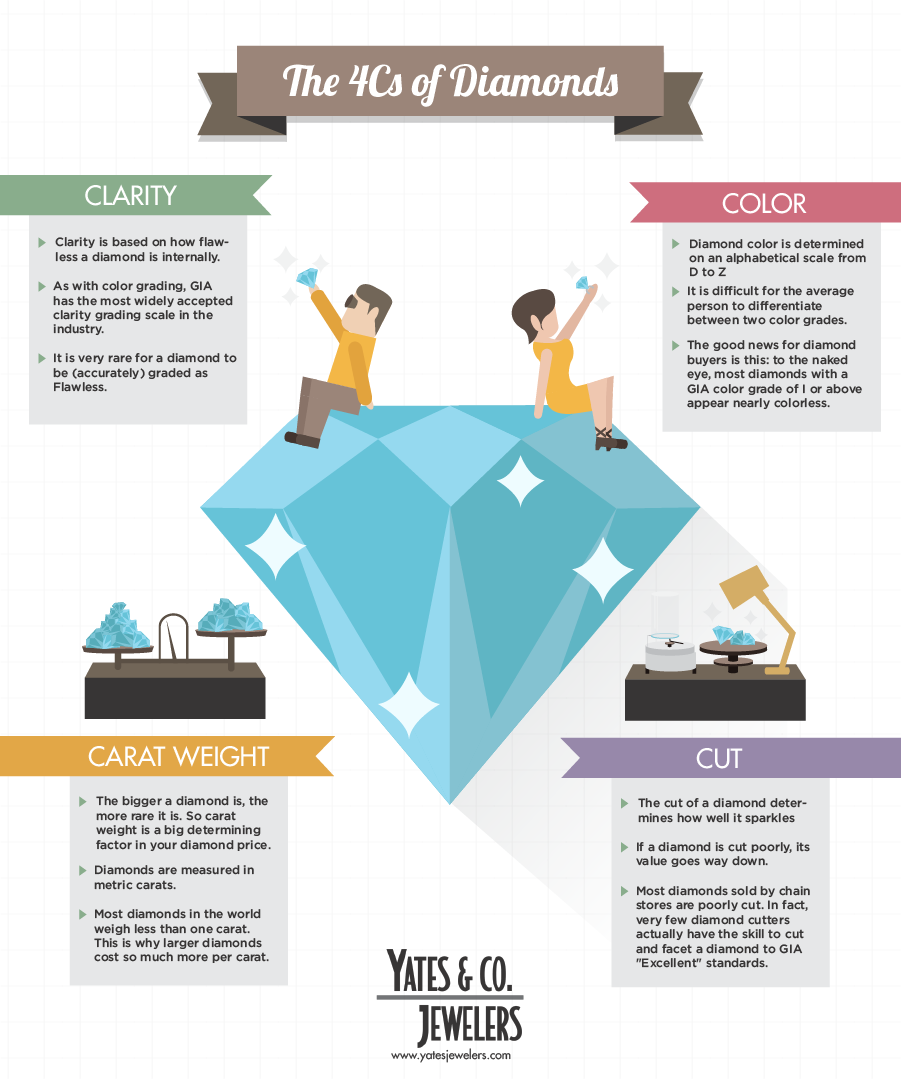Why you need to know this stuff
The price you'll pay for a diamond depends on four factors that determine its overall quality. These four factors are color, cut, clarity and carat weight. These are the "4 Cs" of diamonds. When you are ready to shop for a diamond, you'll need to understand the 4 Cs. An educated buyer is a smart buyer!

COLOR
Diamond color is determined on an alphabetical scale from D to Z. (No, it doesn't start at "A" -sorry!) The scale was created by experts at the GIA over 50 years ago. D-color diamonds have no color at all. Z-color diamonds have a distinctly yellow hue. (Z-color diamonds almost qualify as fancy yellow diamonds, but not quite.)
The price of a diamond climbs as it gets closer to D (highest degree of colorless diamonds) on the GIA color scale. This is because the higher the color rating - the rarer and more desirable the diamond is.
It is difficult for the average person to differentiate between two color grades. For example, if I show you a D-color diamond and an E-color diamond, you would have a hard time seeing the difference. However, if you look at two diamonds side by side that are more than two color grades apart, it becomes fairly easy to see the difference. (For example, a D-color to a F-color grade.)
The good news for diamond buyers is this: to the naked eye, most diamonds with a GIA color grade of I or above appear nearly colorless. So you have a wide range of gorgeous "colorless" diamonds to choose from.
Hint: When comparing color on a diamond, make sure the diamond is on a white background. A white diamond grading paper is what we use. And look at the diamond through its side. That way the brilliance of the diamond is not masking its true color.
CUT
The cut of a diamond determines how well it sparkles. Suppose you have a D-color diamond, with extremely high clarity. If it is not cut properly to create light refraction, then that diamond will not sparkle as well as it could.
If a diamond is cut poorly, its value goes way down. This is because the cut affects a diamond's fire, brilliance and scintillation. Fire refers to those dazzling flashes of color a diamond gives off. Brilliance refers to the total amount of pure white light reflections a diamond gives off. Scintillation refers to the flashes of light your eye catches from a diamond. These flashes occur when you, the light source or the diamond move around.
Most diamonds sold by chain stores are poorly cut. Trying to save money these big jewelry chains and department stores use inexpensive diamond cutters with little skill. In fact, very few diamond cutters actually have the skill to cut and facet a diamond to GIA "Excellent" standards.
Unscrupulous diamond dealers charge high prices for poorly cut diamonds. They draw your attention away from the cut. They focus on carat weight, color and clarity instead. They get away with selling lousy, poorly cut diamonds because they know it is hard for consumers to tell a good cut from a bad cut. That's why it's so important for you to purchase your diamond from a reputable jeweler you can trust. The majority of the diamonds I see that come chain stores look like they were hatchet-cut by a blind man in India. (No offense to my friends in India. There are some fine diamond cutters there. But a bunch of really, really ugly diamonds that are also cut there.)
Hint: If you want your diamond to really sparkle, insist on a GIA graded diamond with an Excellent or Very Good cut grade. Nothing less!
CLARITY
Clarity is based on how flawless a diamond is internally. Nearly every diamond ever cut has some "inclusions" (commonly referred to as "flaws" by the public - I really hate this term!) Inclusions are natural incurred identifying characteristics inside the diamond crystal that were formed eons ago. Examples of internal inclusions are specks of carbon, cracks and cavities. The more inclusions a diamond has, the lower its clarity grade. The fewer the inclusions, the more cash you'll have to put out for that diamond. A diamond with too many inclusions just won't sparkle much.
As with color grading, GIA has the most widely accepted clarity grading scale in the industry. The GIA clarity scale covers diamonds from IF (internally flawless) to I3 (extremely included). SI (slightly included) diamonds fall in the middle of this clarity scale.
It is very rare for a diamond to be (accurately) graded as Flawless. Most people will probably never see one. But that is ok. Because if I showed you a GIA graded Internally Flawless (IF) and a VS-2 (Very Slightly Included-2) you probably would not see the difference with your unaided human eye. Now pop those two diamonds in engagement rings, and you certainly won't see it. But the price difference between the two is enormous.
As with color, there is good news for your wallet: the internal inclusions of SI clarity grade diamonds on brilliant cut diamonds are not visible to the naked eye. Their internal inclusions require 10X magnification to be seen. In addition, it takes an expert to see SI1-grade inclusions under magnification. However, this doesn't hold true for step cut diamonds like Emerald Cuts.
I1-grade inclusions are obvious to anyone who views a diamond under 10X magnification. I1-grade diamonds are very obvious to the unaided eye. And I2-grade diamonds are just plain ugly.
Remember,the fewer inclusions a diamond has, the more it sparkles and the more beautiful it is. And the rarer it is. And rarity equals higher prices.
Hint: To maximize your diamond purchase on a budget, look at an SI-1 or a really nice SI-2 GIA clarity graded diamond. If it has a Very Good Cut it can be just as beautiful as a much higher clarity graded diamond. And save you a bundle!
CARAT WEIGHT
The bigger a diamond is, the more rare it is. So carat weight is a big determining factor in your diamond price.
Diamonds are measured in metric carats. One carat equals 100 points, just as one dollar equals 100 pennies. So, 1.25 carats equals one carat and 25 points. 25 points is another term for a quarter carat.
The term "carat" was actually derived from "carob bean". This is how ancient diamond traders measured the weight of a diamond - with carob beans. Pretty interesting, huh?
You can pay hundreds or thousands of dollars extra for additional points (fractions of a carat) in high quality diamonds. Also, most diamonds in the world weigh less than one carat. Larger diamonds are scarcer. This is why larger diamonds cost so much more per carat.
Hint: When shopping for a diamond, whether engagement ring diamond, or a pair of diamond studs, err on the larger side. It is much better to grow into a larger diamond, than grow out of a smaller diamond. You'll be glad you did. As Elizabeth Taylor said, "Big girls need big diamonds"!

The 4 Cs of Diamonds - An infographic by the team at Yates Jewelers


